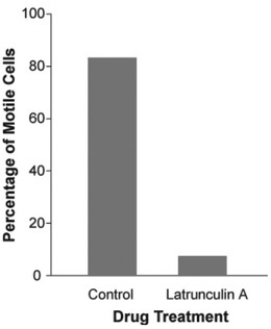Use the following information to answer the question(s) below.
The mechanism of cell crawling in protist species is not well defined. Pseudopodia extension involves interactions between actin and myosin (the same molecules that are involved in vertebrate muscle contraction) . However, prior to the study described below, no one had provided convincing data that actin and myosin were actually involved in cell crawling in protists. Anatomical studies had identified the cytoskeletal protein actin just below the surface of the cell membrane in several species of protist, but physiological studies had failed to show a functional link between actin, myosin, and cell crawling.
In a study by N. Poulsen et al. (Diatom gliding is the result of an actin-myosin motility system, Cell Motility and the Cytoskeleton 44 (1999) :23-22) , researchers tested whether motility in a particular species of diatom involves interactions between actin and myosin. 
-Refer to the study by Poulsen et al. and the accompanying figure. The data graphed in the figure could be an artifact if latrunculin A kills this species of diatoms (that is, that may be why the cells are not moving) . Which of the following would be the best evidence that latrunculin A is NOT killing the cells?
A) When the toxin was washed off the culture, the cells began to move again.
B) There were still a small percentage of motile cells in the culture treated with the toxin.
C) Most of the cells in the control were moving, indicating that they were alive.
D) When the toxin was applied to another species of diatom, 25 percent of them continued to move.
Correct Answer:
Verified
Q1: Imagine that there are 25 different species
Q2: A particular species of protist has obtained
Q4: Encouraging the growth (via nutrient fertilization) of
Q5: Which of the following statements best describes
Q6: Which of the following eukaryotic lineages contains
Q8: Consider the following points: (a) All excavates
Q10: By examining the phylogenetic tree diagrammed in
Q11: All protists are
A) unicellular.
B) eukaryotic.
C) symbionts.
D) monophyletic.
E)
Q11: Use the following information to answer the
Q51: Protists and bacteria are grouped into different
Unlock this Answer For Free Now!
View this answer and more for free by performing one of the following actions

Scan the QR code to install the App and get 2 free unlocks

Unlock quizzes for free by uploading documents